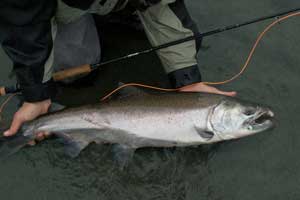Chinook (King) Salmon River Fishing

River fishing has to be one the best habitats to fish for King Salmon. For those that love fly fishing, this is a real treat. King Salmon put up a great fight and hit the line really hard.
Spring is the best time to catch them, but they can be found in rivers any time of the year with some seasons being much more challenging than others.
King Salmon Fishing Lures and Techniques
- Cast into slower moving parts of the river as the salmon have a better chance of seeing the bait and going for it.
King Salmon are more likely to be interested in food when they’re in a fast moving current. It’s like driving to work and eating a burger. Much easier than racing your Corvette around a track and eating burger.
In the lower stretches of the river, back-trolling from a drift boat with diving plugs, such as Kwikfish or Hot Shots, is an excellent way to locate moving fish. When wading in the narrow, upper-river or tributary streams, spoons, spinners or streamers are highly effective.
King Salmon Spawning
Once King Salmon leave the ocean and move upstream they stop feeding, although they may still feed in the first few days entering the mouth of a large river. Most Chinook (King) are caught in a small streams.
However at this time Chinook Salmon have nothing on their minds beside spawning. They are aggressive and territorial, defending their spawning ground from Rainbow and Brown Trout which follow salmon upstream to feed on their eggs.
Chinook Salmon don’t feed at this time, but will hit a lure to defend their territory. Chinook will hit Rapalas or spinners that have rainbow or brown trout colors.
Sometimes they’ll also hit loud colors such as bright red or bright yellow.
- Cast so that the lure or fly drops just in front of them. Too far away and they won’t attack the lure.
As they swim upstream, they genetically start to disintegrate. Usually by the time they finish spawning, they are almost dead.
This is where Atlantic Salmon differ from Pacific Salmon as about 20% or more Atlantic Salmon survive spawning whereas only about 4% of Chinook Salmon survive after spawning.



